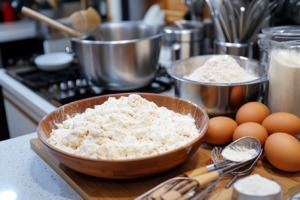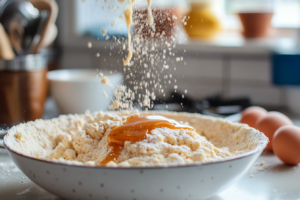Introduction and Overview of Din Tai Fung Vinegar
Din Tai Fung, famous worldwide for its steamed dumplings and authentic Chinese flavors, uses a signature vinegar that enhances the savory and umami flavors of its dishes. The vinegar they use is Chinese black vinegar, specifically Chinkiang vinegar (Zhenjiang vinegar).
This dark, complex vinegar is known for its rich, smoky taste, making it perfect for dipping sauces, noodle recipes, and stir-fry dishes. Its bold acidity and balanced sweetness create the perfect pairing for dumplings, bao buns, and wontons.
Additionally, Chinkiang vinegar has deep historical roots in Chinese cuisine, being a staple condiment in Asian kitchens for centuries. Its distinctive taste comes from fermented glutinous rice and wheat bran, which develop its dark color and earthy aroma.
Types of Vinegar Commonly Used in Chinese Cuisine
Chinese cuisine uses a wide variety of vinegars to enhance its signature flavors. Here are the most common types:
Chinkiang Vinegar (Black Vinegar):
- Most popular in Northern Chinese cuisine.
- Flavor: Rich, tangy, slightly sweet.
- Best For: Dumplings, noodles, stir-fries.
Rice Vinegar:
- Mild and lightly sweet.
- Flavor: Gentle acidity.
- Best For: Sushi, salads, marinades.
White Vinegar:
- Sharp and acidic, often used in pickling.
- Best For: Preserved vegetables, pickled radishes.
Red Vinegar:
- Sweet and tart, commonly used in Cantonese dishes.
- Best For: Seafood sauces, BBQ recipes.
Additionally, understanding these vinegar varieties can enhance your cooking skills and expand your culinary creations.
What Vinegar Din Tai Fung Uses and Why It’s Special
Din Tai Fung’s iconic dipping sauce wouldn’t be the same without Chinkiang vinegar. Here’s why this specific vinegar is essential to their dishes:
Why Chinkiang Vinegar?
- Rich, Bold Flavor:
- Its dark, smoky taste perfectly balances salty soy sauce and aromatic ginger.
- Authentic Chinese Taste:
- Chinkiang vinegar is a core element of traditional Chinese recipes, offering an authentic culinary experience.
- Perfect for Dumplings:
- Its complex acidity cuts through rich fillings like pork, shrimp, or mushrooms, enhancing flavor depth.
- Versatility:
- It’s not just for dipping sauces. Use it in marinades, soups, and noodle stir-fries for extra flavor.
Key Characteristics of Chinkiang Vinegar:
- Color: Dark brown to black.
- Taste: Smoky, tangy, with a slight sweetness.
- Ingredients: Fermented glutinous rice, wheat bran, and water.
Additionally, this vinegar’s long fermentation process creates its deep, rich flavor, making it irreplaceable in authentic Chinese cooking.
How to Use This Vinegar in Recipes
Chinkiang vinegar is extremely versatile and can elevate a wide range of Asian-inspired recipes. Here’s how to use it effectively:
Classic Dumpling Dipping Sauce:
- Mix 2 parts soy sauce, 1 part Chinkiang vinegar, and fresh ginger strips.
- Use as a dipping sauce for dumplings, wontons, and bao buns.
Stir-Fry Recipes:
- Add a splash of Chinkiang vinegar to stir-fried vegetables, beef noodles, or fried rice for added depth.
Marinades and Dressings:
- Mix with soy sauce, honey, and garlic to create a savory marinade for meat, tofu, or seafood.
Asian-Style Soups:
- Add a few drops to hot and sour soup, noodle broth, or pork stew for enhanced complexity.
Salad Dressings:
- Whisk together Chinkiang vinegar, olive oil, honey, and mustard for an Asian-inspired vinaigrette.
Use this link when discussing homemade baking mixes, easy breakfast recipes, or baking tips related to hotcakes and pancakes.
Vinegar Alternatives for Din Tai Fung Recipes
If Chinkiang vinegar is unavailable, there are several substitutes you can use to replicate its unique flavor. Here are some of the best alternatives:
Balsamic Vinegar
- Flavor Profile: Sweet and tangy like Chinkiang vinegar, though slightly sweeter.
- Best For: Dumpling sauces, stir-fries, and glazes.
- Tip: Mix with soy sauce for a better match.
Rice Vinegar + Soy Sauce
- Flavor Profile: Mild and lightly acidic. Adding soy sauce enhances umami depth.
- Best For: Noodle dishes and dipping sauces.
Red Wine Vinegar + Sugar
- Flavor Profile: Tangy and acidic. Adding a small amount of sugar helps balance the taste.
- Best For: Marinades, salad dressings, and stir-fries.
Apple Cider Vinegar + Soy Sauce
- Flavor Profile: Sharp and fruity. The soy sauce adds a savory depth.
- Best For: Pork dishes and dumpling sauces.
Additionally, while these alternatives may not exactly replicate Chinkiang vinegar, they can enhance flavors and create delicious results in home-cooked meals.
Common Mistakes When Using Chinese Vinegar and Fixes
Even with authentic ingredients, using Chinese vinegar incorrectly can affect the taste of your dishes. Here are common mistakes and how to fix them:
Using Too Much Vinegar
- Mistake: Adding too much vinegar can overwhelm the dish.
- Fix: Use only 1-2 tablespoons, and adjust gradually. Start small and taste as you go.
Adding Vinegar Too Early
- Mistake: Adding vinegar too early during cooking can weaken its flavor.
- Fix: Add vinegar near the end to retain its tangy sharpness.
Not Balancing Flavors
- Mistake: Using vinegar alone can make the dish taste one-dimensional.
- Fix: Mix vinegar with soy sauce, sugar, or ginger to balance flavors.
Using the Wrong Vinegar Type
- Mistake: Substituting with white vinegar can cause harsh acidity.
- Fix: Use Chinkiang vinegar or a similar dark vinegar for authentic taste.
Not Storing Properly
- Mistake: Storing vinegar in direct sunlight can alter its taste.
- Fix: Store in a cool, dark place in a sealed bottle.
Additionally, using correct portions, balancing ingredients, and adding vinegar at the right stage will elevate your dishes.
FAQs About Din Tai Fung Vinegar Detailed Guide
Can I Use Rice Vinegar Instead of Chinkiang Vinegar?
Yes, you can use rice vinegar as a substitute for Chinkiang vinegar, but keep in mind that it is lighter and less complex. To achieve a similar depth of flavor, add:
- Soy Sauce: For added umami and saltiness.
- Balsamic Vinegar: To introduce a sweet and tangy balance.
Additionally, adjusting the ratio of rice vinegar to soy sauce (2:1) can better replicate the taste of Chinkiang vinegar.
How Long Does Chinese Black Vinegar Last?
Proper storage can extend the shelf life of Chinese black vinegar to 1-2 years. To preserve its quality, follow these tips:
- Keep It Sealed: Ensure the bottle has a tight-fitting cap.
- Store in a Cool, Dark Place: Avoid direct sunlight and high temperatures.
- Check for Changes: Discard if it develops a strange odor, unusual color, or sediment buildup.
Additionally, refrigeration is optional but recommended in humid climates.
Can I Use Black Vinegar for Marinades?
Absolutely! Its tangy, smoky flavor makes it an excellent addition to meat marinades, stir-fries, and dumpling sauces.
- Best Uses:
- Pork, beef, and chicken marinades
- Stir-fried vegetables
- Glazes for roasted meats
Tip: Combine black vinegar, soy sauce, honey, and garlic for a savory-sweet marinade.
What Dishes Can I Make with Black Vinegar?
Chinese black vinegar is extremely versatile and works well in a variety of dishes:
- Dumpling Dipping Sauces: Mix with soy sauce, ginger, and chili oil.
- Stir-Fries: Enhance noodles, fried rice, and vegetable stir-fries.
- Soup Bases: Add a splash to hot and sour soup or noodle broths.
- Asian Salads: Use in vinaigrettes with olive oil, honey, and sesame oil.
Additionally, black vinegar can be used to balance richness in meat-based stews and braised dishes.
Is Chinkiang Vinegar Gluten-Free?
Traditional Chinkiang vinegar may contain wheat as part of its fermentation process, making it not gluten-free by default.
- How to Choose a Gluten-Free Option:
- Check Labels: Look for products labeled “gluten-free.”
- Certified Brands: Opt for certified gluten-free brands when available.
- Rice-Based Alternatives: Use rice vinegar or gluten-free soy sauce if gluten-free Chinkiang vinegar isn’t available.
Additionally, many health-conscious brands have started producing wheat-free alternatives to accommodate dietary restrictions.
Conclusion:
In conclusion, Chinkiang vinegar is an indispensable ingredient that defines the unique flavor of many Chinese dishes, including those served at Din Tai Fung. Its rich, smoky taste, balanced acidity, and mild sweetness create a flavorful depth that enhances dumplings, stir-fries, noodles, and soups.
Even if Chinkiang vinegar is unavailable, there are several effective alternatives like balsamic vinegar, rice vinegar mixed with soy sauce, or apple cider vinegar. These substitutes can mimic its tangy profile, ensuring that you can still create delicious Asian-inspired dishes at home.
Moreover, understanding how to use vinegar correctly is crucial for culinary success. Avoid common mistakes like overuse, adding vinegar too early, or using the wrong type. Learning to balance flavors with complementary ingredients like soy sauce, garlic, ginger, and sugar can elevate your dishes to a restaurant-quality level.
Additionally, proper storage is key to maintaining the vinegar’s quality. Keep it sealed tightly in a cool, dark place and avoid direct sunlight. Check for any unusual changes in color, odor, or texture to ensure its freshness.
Finally, experimenting with new recipes and creating custom sauces using Chinkiang vinegar can enhance your cooking experience. Whether you’re making dumpling dipping sauces, hot and sour soup, or Asian-style marinades, this versatile ingredient will undoubtedly transform your meals.
Start exploring its uses and unleash your creativity in the kitchen. With the right techniques, you can recreate authentic flavors and enjoy the taste of Din Tai Fung’s dishes from the comfort of your own home. Happy cooking!
Hotcake Mix Recipe – Use this link when suggesting creative recipe adaptations using pantry ingredients like vinegar in baking or savory toppings.



